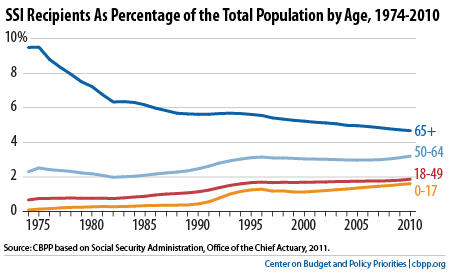A House Ways and Means subcommittee will hold a hearing tomorrow on Supplemental Security Income (SSI) benefits for disabled children to consider the program’s future. SSI provides monthly cash assistance to people who are disabled, blind, or elderly and have little income and few assets; in September 2011, 8 million people collected SSI benefits — including 1.3 million children under 18.
Here are some important things that lawmakers should know about SSI for disabled children:
- Its benefit rolls have grown only slightly faster than the population. About 1.6 percent of all children in the United States collect SSI; that’s only a bit higher than in the mid-1990s, when Congress last overhauled the program (see graph). The rising rate of child poverty and advances in early diagnosis of medical and psychiatric conditions help to explain this modest growth.
- It lifts recipients out of poverty. The maximum federal benefit for a disabled child is $674 per month; the average benefit is $588. Most families are below the poverty line without the SSI payment but above the line with it.
- Its medical criteria are stringent. To qualify for the program, a child’s impairments must match (or equal in severity) a list of disabling conditions compiled by the Social Security Administration (SSA). Qualified medical professionals — physicians, licensed or certified psychologists, and certain other experts such as speech pathologists — must submit evidence; statements by parents and teachers aren't enough. SSA approves only about 40 percent of applications.
- Cases are subject to frequent review. Children’s conditions may change; the law directs SSA to review their eligibility at least every three years (or sooner, in the case of low-birthweight babies). These reviews lead to benefit terminations for about 20 percent of cases overall and about half of low-birthweight babies. Also, special reviews that occur at age 18 end benefits for over one-third of children reaching that milestone. In the recent Budget Control Act, Congress gave future appropriators enough room to fund those “program-integrity” activities even in a tight budget environment.
The National Academy of Social Insurance (NASI) examined the SSI program for disabled children as Congress debated changes to the program in the mid-1990s and concluded that — while some reforms were merited — it serves a compelling need. As they review this program, lawmakers should remember its vital importance to some of America’s most vulnerable children and families.
